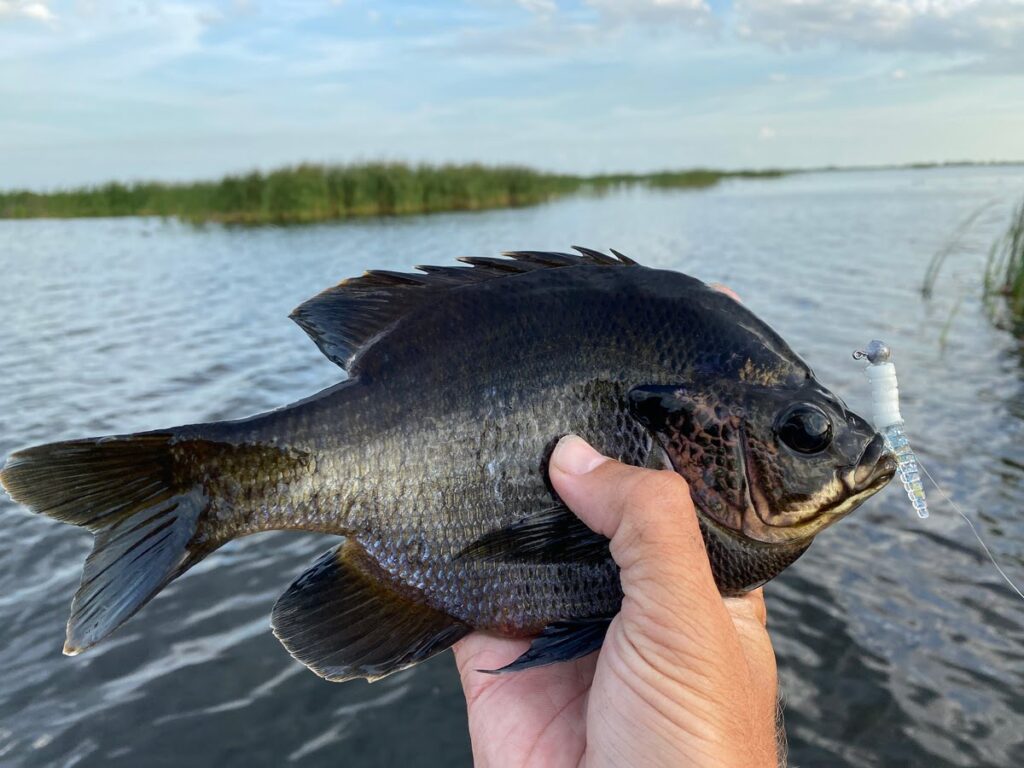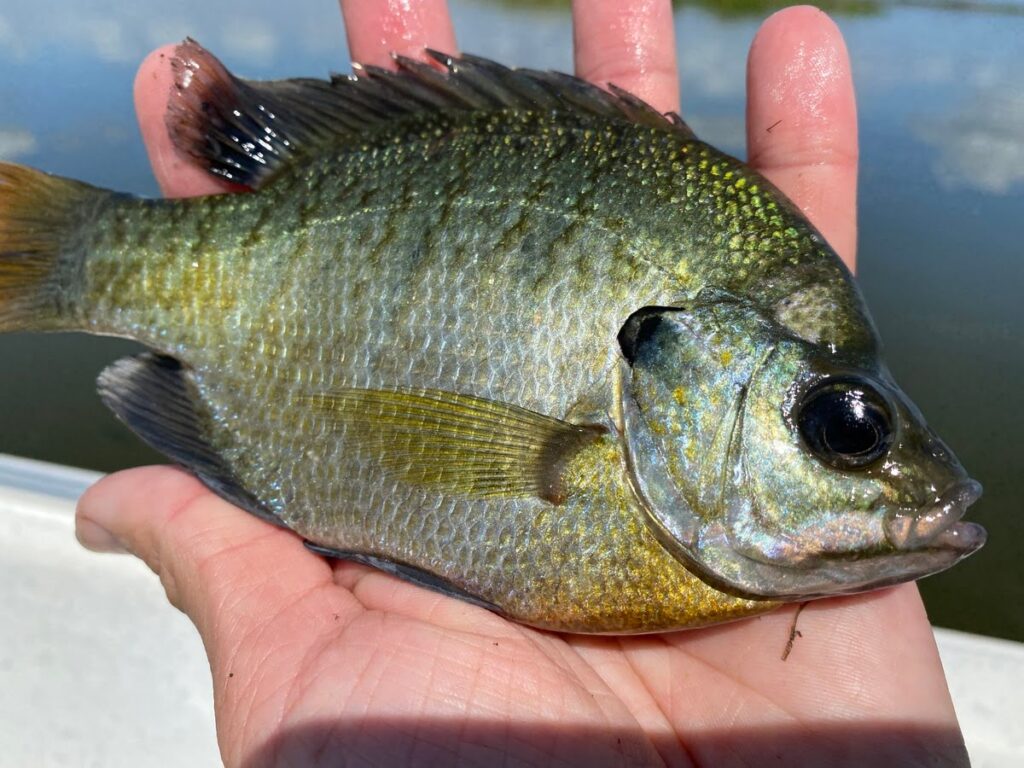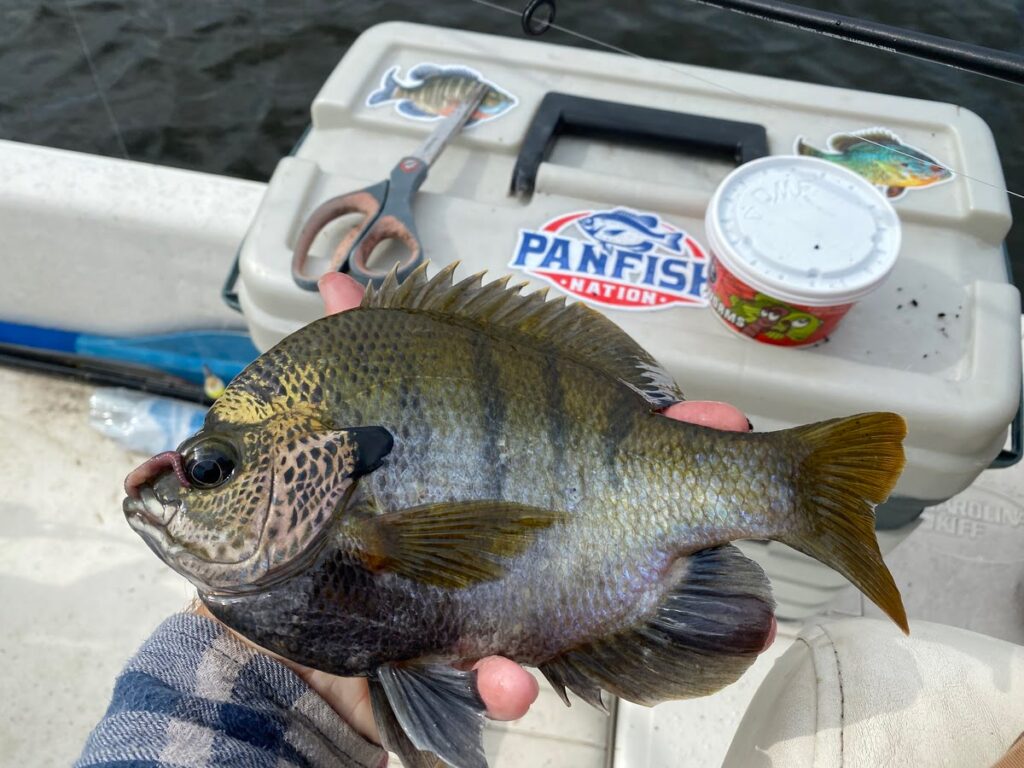Countless anglers can point to the ever-present bluegill as their first fish, including myself! A palm-sized bluegill in Northeastern Ohio is what started me down the path of fishing that I still walk today, so I’ll always have a special place for them in my heart.
However, on April 9, 1950, an angler named T.S. Hudson caught a bluegill like none that had come before.. and none that have come since.
Let’s dive into some of the most interesting and crazy facts about the biggest bluegill ever caught, and how just maybe, you can catch an even bigger one someday!
Table of Contents
The Lowdown on Bluegills

Bluegill sunfish (Lepomis macrochirus) are one of the most well-known fish in the US. It’s easy to see why; they’re found from coast to coast, tolerant of a wide variety of water conditions, and eagerly snap up almost any natural or artificial bait you put in front of them.
These panfish average less than 8 inches long, and usually weigh less than a pound. But under the perfect conditions, bluegills can become much, MUCH more than the little bait-stealers we all know them as. In fact, the record fish clocked in at a whopping 4 ¾ pounds and 15 inches long!
These perfect conditions can be hard to come by, but by looking at where previous monster bluegills have been found we may be able to figure out where to look next.
Artificial Breeding Ground: The Ketona Lakes
The world record bluegill, referred to reverently as “Hudson’s Hawg,” came from an abandoned quarry system in Alabama known as the Ketona Lakes. A leak had caused the old dolomite mines to fill rapidly with spring water in the 1940’s, and the lakes were born.
The way the mines were dug meant that the newborn lakes were quite deep, and the limestone mine walls filtered the water, making it exceptionally clear. Ketona’s location in the US South meant that the water never froze over in the winter, either.
These deep, clear, and warm conditions seem to be the secret to breeding trophy bluegills. Despite the artificial nature of this water, it unlocked the hidden potential that always lurked within the genes of these humble sunfish!
In fact, Ketona is the home of not just one, but two different record fish! More on this later.
Less is More: Simple Tackle Does the Trick

Bluegills are known to be voracious little hunters, eating anything and everything in their path. I’ve caught smaller fish on everything from spinners, to worms, and even hotdog chunks!
The massive fish of the Ketona Lakes, however, seem to be a bit pickier. The crystal-clear water means that these monster fish have an easier time telling lures from their actual food.
Nowadays, we have technology like fluorocarbon line to aid with fooling those eagle-eyed fish. But 73 years ago, the best way to convince them to bite was to have as little extra tackle as possible.

This is what gave rise to the seemingly primitive tackle used to catch the Hawg: A single redworm was slipped onto a number 3 Harrison brand hook, completely unweighted, on a cane pole with 6-pound line and a quill bobber.
The worm was allowed to sink to around 5 feet down, and then all that’s left to do is wait for a bite. You know what they say: “if it ain’t broke, don’t fix it!”
Location is Key: The Coppernose Question

One reason that the South may be the home of so many monsters is that it’s the native range of a special subspecies of bluegill called the coppernose.
While they are still considered bluegills, their genetic isolation from the rest of the population has led to them adopting slightly different behavior, including growing faster and feeding more aggressively than other bluegills!
I could find no documentation on whether or not Hudson’s Hawg was a coppernose or not, but given the location it certainly seems like this could explain the region’s larger than average fish. Read our article on coppernose bluegills if you want to learn more about these mutant monsters!
A Long Standing Record
Despite Hudson’s Hawg being caught over 70 years ago, it’s still the record. Why is this?
It could be that bluegill simply don’t get much bigger than that. 4-pounders have been caught in similar warm, clear lakes across the country, but none have topped the 4 pounds and 12 ounces that Hudson landed on that April morning.
Still, some people are convinved that a 5 pound fish is not only possible, but inevitable. Ketona Lakes are now private ponds, unfishable by the public, but trophy anglers continue to test their luck at those deep, clear and warm lakes that may hold the next monster.
Some think this 5-pounder has already been caught, and from the same pond to boot! Let’s hear about the previously mentioned other world-record bluegill from Ketona.
Only Second Best? The McKenzie Monster
When Hudson’s Hawg was weighed in, it broke a record that had only been set 3 years prior. This fish, caught by Coke McKenzie, weighed only 2 ounces less at 4 pounds and 10 ounces.
The thing is, Hudson’s fish was weighed immediately upon landing, whereas McKenzie’s sat for 20 hours to dry and decompose before its weigh-in. In an interview, McKenzie has publicly shared his belief that his fish was bigger than the Hawg.
“I should have weighed that fish right away. I know it had to weigh at least 5-pounds. I’m sure it was larger than Hudson’s fish that got weighed right away. I saw both fish mounted, and mine was bigger,” McKenzie said.
Conclusion
While the bluegill world record has not been broken for over half a century, their massive potential hasn’t gone anywhere. The most accessible fish in America still has the potential to grow to even larger sizes.
Not to mention that the world record for its close cousin, the black crappie, was broken only recently in 2018!
If McKenzie’s claim is to be believed, 5 pound bluegills are indeed possible. And if that’s the case, it’s only a matter of time until another one turns up. Maybe you’ll be the lucky angler to nab it! Hopefully it can be weighed immediately when you do.
Good luck, and tight lines- no matter the size of the fish!
If you haven’t guessed yet, I love fishing and everything about it!
To learn more about why I started Panfish Nation, visit the About page and follow along on Social Media:


Download a copy of my FREE Lure Color Selection Chart & Knot Guide!
Stay up to date with fishing reports, tackle reviews, industry news, and much more! We respect your privacy, unsubscribe at any time.
